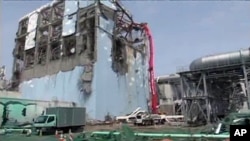Leaders of Japan, China and South Korea will visit Fukushima City, northwest of the crippled Fukushima Daiichi nuclear power plant, at the start of a trilateral summit this weekend.
The visit will take place before regular meetings get under way in Tokyo at the fourth such annual summit among the three countries.
The summit is expected to cover a range of regional issues. Among them will be enhanced cooperation in disaster preparedness and response.
China and South Korea both provided rescue teams and aid to Japan in the days following the March 11 earthquake and tsunami.
Japanese Prime Minister Naoto Kan is keen to build on that goodwill. He says ties between Japan and the two countries have been extended and deepened by the crisis and he would like to use that to create stronger links between the neighbors.
The summit meeting will also give Japan a chance to directly brief Chinese Premier Wen Jiabao and South Korean President Lee Myung Bak on the plan to bring the Fukushima Daiichi nuclear plant back to a stable condition.
Japan was criticized by China and South Korea, in the early days of the crisis, for failing to share information, including on the planned release of thousands of tons of low-level radioactive water into the Pacific Ocean.
At the nuclear power plant on Wednesday, workers entered the number two reactor building for the first time since an explosion on March 15.
Tokyo Electric spokesman Junichi Matsumoto says four workers entered the building "to take radiation measurements and check equipment, but could only remain inside for 14 minutes. He said Thick clouds of steam, thought to be from water evaporating in the spent fuel pool, is hampering their work.
A robot that previously entered the building measured the humidity and temperature at about the same as that of a steam bath or sauna.
Despite the difficult work environment, workers need to go inside to build a new cooling system that will take radioactive water from inside the building, filter it and re-circulate it back inside.







